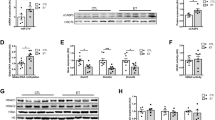Abstract
Purpose
Vigorous physical activity after diagnosis of localized prostate cancer may reduce the risk of disease progression and prostate cancer-specific mortality. The molecular mechanisms by which physical activity may exert protective effects in the prostate remain unknown.
Methods
We examined the associations between self-reported physical activity and gene expression patterns in morphologically normal prostate tissue of 71 men with low-risk prostate cancer on active surveillance. Differential gene expression, gene set, and pathway analyses were conducted comparing dichotomous groups defined by type, intensity, and amount of physical activity reported.
Results
Cell cycling and DNA repair pathways were up-regulated in men who participated in ≥ 3 h/week vigorous activity compared with men who did not. In addition, canonical pathways involved in cell signaling and metabolism, the cellular effects of sildenafil (Viagra), and the Nrf2-mediated oxidative stress response were modulated in men who reported ≥ 3 h/week of vigorous activity. Differential expression analysis at the individual gene level revealed modest differences between men who performed vigorous activity for ≥ 3 h/week and those who did not. There were no differences in prostate gene expression in comparisons with exercise groupings that did not consider both duration and intensity of activity.
Conclusions
Prostate gene expression and pathway analyses revealed sets of transcripts that may be modulated in normal prostate tissue by participating in ≥ 3 h/week of vigorous activity after diagnosis of low-risk prostate cancer. These findings suggest potential biological mechanisms by which vigorous activity may reduce risk of prostate cancer progression and warrant further study and validation.

Similar content being viewed by others
References
Prostate (2012) SEER stat fact sheets. November 2011 SEER data submission: National Cancer Institute
Dall’Era MA, Cooperberg MR, Chan JM et al (2008) Active surveillance for early-stage prostate cancer: review of the current literature. Cancer 112:1650–1659
Magbanua MJ, Roy R, Sosa EV et al (2011) Gene expression and biological pathways in tissue of men with prostate cancer in a randomized clinical trial of lycopene and fish oil supplementation. PLoS ONE 6:e24004
Ornish D, Magbanua MJ, Weidner G et al (2008) Changes in prostate gene expression in men undergoing an intensive nutrition and lifestyle intervention. Proc Natl Acad Sci USA 105:8369–8374
Chan JM, Weinberg V, Magbanua MJ et al (2011) Nutritional supplements, COX-2 and IGF-1 expression in men on active surveillance for prostate cancer. Cancer Causes Control 22:141–150
Kenfield SA, Stampfer MJ, Giovannucci E, Chan JM (2011) Physical activity and survival after prostate cancer diagnosis in the health professionals follow-up study. J Clin Oncol 29:726–732
Richman EL, Kenfield SA, Stampfer MJ, Paciorek A, Carroll PR, Chan JM (2011) Physical activity after diagnosis and risk of prostate cancer progression: data from the cancer of the prostate strategic urologic research endeavor. Cancer Res 71:3889–3895
Jones LW, Antonelli J, Masko EM et al (2012) Exercise modulation of the host-tumor interaction in an orthotopic model of murine prostate cancer. J Appl Physiol 113:263–272
Physical Activity Guidelines Advisory Committee (2008) Physical activity advisory committee report, 2008. Department of Health and Human Services, Washington
Tusher VG, Tibshirani R, Chu G (2001) Significance analysis of microarrays applied to the ionizing radiation response. Proc Natl Acad Sci USA 98:5116–5121
Dinu I, Potter JD, Mueller T et al (2007) Improving gene set analysis of microarray data by SAM-GS. BMC Bioinform 8:242
Efron B, Tibshirani R (2007) On testing the significance of sets of genes. Ann Appl Stat 1:107–129
Diehn M, Sherlock G, Binkley G et al (2003) SOURCE: a unified genomic resource of functional annotations, ontologies, and gene expression data. Nucleic Acids Res 31:219–223
Subramanian A, Tamayo P, Mootha VK et al (2005) Gene set enrichment analysis: a knowledge-based approach for interpreting genome-wide expression profiles. Proc Natl Acad Sci USA 102:15545–15550
Benjamini Y, Hochberg Y (1995) Controlling the false discovery rate—a practical and powerful approach to multiple testing. J R Stat Soc B Met 57:289–300
Radak Z, Naito H, Kaneko T et al (2002) Exercise training decreases DNA damage and increases DNA repair and resistance against oxidative stress of proteins in aged rat skeletal muscle. Pflugers Arch 445:273–278
Siu PM, Pei XM, Teng BT, Benzie IF, Ying M, Wong SH (2011) Habitual exercise increases resistance of lymphocytes to oxidant-induced DNA damage by upregulating expression of antioxidant and DNA repairing enzymes. Exp Physiol 96:889–906
Rundle A (2005) Molecular epidemiology of physical activity and cancer. Cancer Epidemiol Biomark Prev 14:227–236
La Vignera S, Condorelli R, Vicari E, D’Agata R, Calogero AE (2012) Physical activity and erectile dysfunction in middle-aged men. J Androl 33:154–161
Shamloul R, Ghanem H (2013) Erectile dysfunction. Lancet 381:153–165
Goeman JJ, Buhlmann P (2007) Analyzing gene expression data in terms of gene sets: methodological issues. Bioinformatics 23:980–987
Tian L, Greenberg SA, Kong SW, Altschuler J, Kohane IS, Park PJ (2005) Discovering statistically significant pathways in expression profiling studies. Proc Natl Acad Sci USA 102:13544–13549
Strasser B, Steindorf K, Wiskemann J, Ulrich CM (2013) Impact of resistance training in cancer survivors: a meta-analysis. Med Sci Sports Exerc 45:2080–2090
Acknowledgments
We thank the patients who participated in this study; Ritu Roy for providing assistance with preprocessing the raw gene expression data; Adam Olshen for the critical review of the manuscript; the Prostate Cancer Foundation; and the National Cancer Institute/National Institutes of Health for funding. NIH/NCI R01CA101042 and R25CA112355; Prostate Cancer Foundation.
Author information
Authors and Affiliations
Corresponding author
Additional information
Mark Jesus M. Magbanua and Erin L. Richman have contributed equally to this work.
Electronic supplementary material
Below is the link to the electronic supplementary material.
Rights and permissions
About this article
Cite this article
Magbanua, M.J.M., Richman, E.L., Sosa, E.V. et al. Physical activity and prostate gene expression in men with low-risk prostate cancer. Cancer Causes Control 25, 515–523 (2014). https://doi.org/10.1007/s10552-014-0354-x
Received:
Accepted:
Published:
Issue Date:
DOI: https://doi.org/10.1007/s10552-014-0354-x




